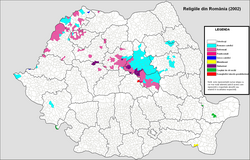This article needs additional citations for verification. (November 2014) |
Zalmoxianism (Romanian: Zalmoxianism) or Zamolxianism[1] (Romanian: Zamolxianism) is a Neopagan movement in Romania which promotes the rebuilding of an ethnic religion and spirituality of the Romanians through a process of reconnection to their ancient Dacian and Thracian roots.[2] The religion takes its name from Zalmoxis or Zamolxe, at the same time the name of the primordial god and the archetype of the enlightened man in Paleo-Balkan mythology. Scholars Bakó and Hubbes (2011) have defined Zalmoxianism, like the other ethnic religious revivals of Europe, as a reconstructionist ethno-paganism.[3]
Origins
[edit]The reconstruction of ancient Dacian and Thracian religion and mythology has been strictly connected with the field of dacology.[4] Amongst contemporary supporters of Zalmoxianism, the emigrant dacologist Octavian Sărbătoare even proposed to make it the official religion of Romania.[5]
Organisations
[edit]The Gebeleizis Society
[edit]The "Gebeleizis Society" (Romanian: Societatea Gebeleizis), though far from being the only Zalmoxian group in Romania, has been the most studied formation.[6] It has 500 members split into 15 branches.[7] The core values of the organisation are expressed by its motto "One Family, One Nation, One Territory" (Romanian: O Familie, Un Neam, Un Teritoriu);[8] for the ideas promoted, the Gebeleizis Society has been subject of media scandal, and accused of extremism.[9]
Zamolxe group
[edit]Another group is the Zamolxe, based in Bucharest, whose high priest is Alexandru Mihail. They worship the old Thraco-Dacian pantheon of gods, and claim that the name "Zalmoxis" comes from zamol, meaning "earth".[10]
-
Symbol of Zamolxiana New Religious Movement.
-
Dacian Sacred Fire ceremony at Detunata temple during 2013 in Romania.
-
The Dacian Sacred Fire at Costesti, Romania, in 2012.
Eastern Pagan Front
[edit](Romanian: Frontul Păgân de Răsărit), the purpose of this group consists in the investigation, research and recovery of old traditions, of authentic Thracian-Dacian values, their knowledge and the raising of new generations of ethnic Romanians in the spirit of Zalmoxianism.
The group largely operates on Telegram, often posting paragraphs, photos, and more with an anti-Christian sentiment and a pro-Pagan perspective. They are at times recognized as a National-Socialist group, known for its pro-folkish outlook on Paganism.
See also
[edit]References
[edit]- ^ Bakó-Hubbes, 2011, pp. 139-140
- ^ Bakó-Hubbes, 2011, p. 129
- ^ Bakó-Hubbes, 2011, p. 131
- ^ Bakó-Hubbes, 2011, p. 137
- ^ Bakó-Hubbes, 2011, p. 140
- ^ Bakó-Hubbes, 2011, p. 136
- ^ Bakó-Hubbes, 2011, p. 149: quoting Margareta Lupu
- ^ Bakó-Hubbes, 2011, p. 143
- ^ Bakó-Hubbes, 2011, p. 142
- ^ Maras Loks: Zamolxe Archived 2016-03-14 at the Wayback Machine
Bibliography
[edit]- László-Attila Hubbes. Romanian Ethno-Paganism: Discourses of Nationalistic Religion in Virtual Space. In Native Faith and Neo-Pagan Movements in Central and Eastern Europe. Kaarina Aitamurto, Scott Simpson. Acumen Publishing, 2013. ISBN 1844656624
- Rozália Klára Bakó, László-Attila Hubbes. Religious Minorities' Web Rhetoric: Romanian and Hungarian Ethno-Pagan Organizations. Journal for the Study of Religions and Ideologies, vol. 10, issue 30, Winter 2011: 127–158. ISSN 1583-0039
External links
[edit]- Societatea Gebeleizis ("Gebeleizis Association")
- Spiritualitate Daco-Românească ("Daco-Romanian Spirituality")
- Octavian Sarbatoare. The Foundations of Zamolxiana New Religious Movement, 2014. ISBN 9780992446819




